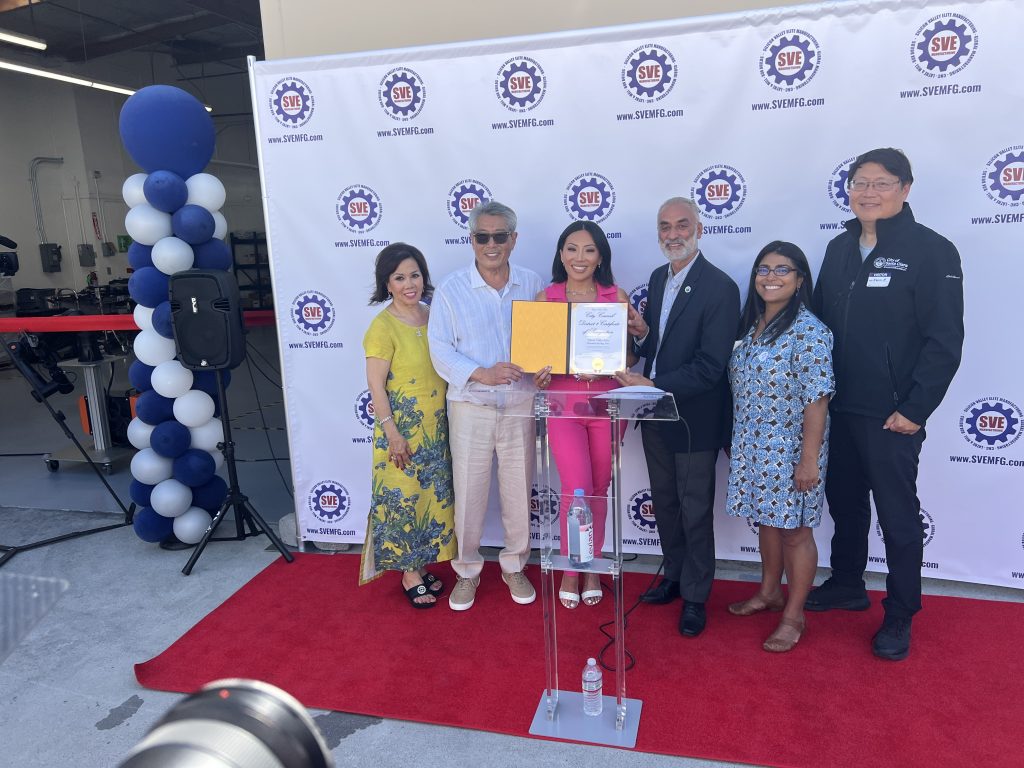One Santa Clara business is positioning itself for the return of manufacturing to America.
In July, Silicon Valley Elite Manufacturing (SVEM), 460 Aldo Ave., cut the ribbon on a new plant. Expanding into a larger space, SVEM hosted community leaders, its 20 employees, their families and city officials. A robot cut the ribbon.
“We are gearing up for the re-shoring and the manufacturing that is headed our way here in America,” said Christine Ngo, vice president of operations and business development at SVEM. “We were already growing out of that old space, and we anticipated more growth ahead.”
SVEM is a precision machine shop using computer numerical control (CNC) — a manufacturing process where software controls factory tools and machinery. Ngo called CNC the “backbone of modern manufacturing.”
It serves industries such as aerospace, medical devices, robotics and semiconductor. The business specializes in delivering high-quality, complex components with tight tolerances, providing what Ngo called a “white-glove” service, combining advanced technology with meticulous craftsmanship, reliability and exceptional customer care.
Manufacturing is Silicon Valley’s second-largest employer, making up 18% of all jobs in Santa Clara, according to the city.
Ngo said she wants to bring “the glam into manufacturing.”
Reena Brilliot, Santa Clara’s director of economic development and sustainability, attended the event.
“By reshoring operations and choosing to grow here at home, Elite is not only creating quality jobs but also strengthening our local economy,” Brilliot wrote in a statement after the event. “Their expertise in designing prototypes for some of the world’s leading technology companies makes them an indispensable partner in the innovation ecosystem.”
Ngo said manufacturing “feeds the ecosystem” that creates jobs.
Every 100 durable manufacturing jobs, of which CNC machining is a part, generates 744 indirect jobs, according to a 2019 study by the Economic Policy Institute, a Washington, D.C.-based think tank. That number is third, behind only the 958 indirect jobs utilities generate and the 880 indirect jobs real estate and rental leasing generate.
Taking a collaborative approach, Ngo said she doesn’t see other machine shops as competitors. Instead, if they are getting business, it is an indicator that manufacturing is thriving.
“When they are successful, we are all successful,” she said. “When one shop is winning, everyone wins.”
Harbir Bhatia, CEO and president of Silicon Valley Chamber of Commerce, wrote in a statement after the ribbon cutting that, as a woman in a traditionally male-dominated field, Ngo is breaking through barriers.
She confirmed Ngo’s collaborative approach, noting how she invited partners in the manufacturing ecosystem to share their work at the ribbon cutting, reflecting the “spirit of the industry.”
“Manufacturing remains a cornerstone and critical path of America’s economic success and long-term sustainability, driving innovation, expanding expertise, and creating opportunity for future business owners and workforce,” Bhatia wrote.
Silicon Valley isn’t just a tech hub, Ngo said, it’s where ideas become prototypes, and prototypes become products. The goal of automation and robotics is not to replace jobs, but to empower workers to perform higher-skilled tasks and increase productivity, she added.
“If we want to bring back manufacturing back to this country, we need to train the next generation of workers,” Ngo said. “It isn’t man versus robot. It is man with robot.”
Contact David Alexander at d.todd.alexander@gmail.com
Other Local Business Posts:
Wag Hotels Settles Civil Suit with Santa Clara, San Francisco and San Mateo Counties
Empire Armadillo: For the Sake of a Chicken Sandwich, a Restaurant Was Born
Ceribell: Sunnyvale Company Uses AI to Identify Seizures in Patients
